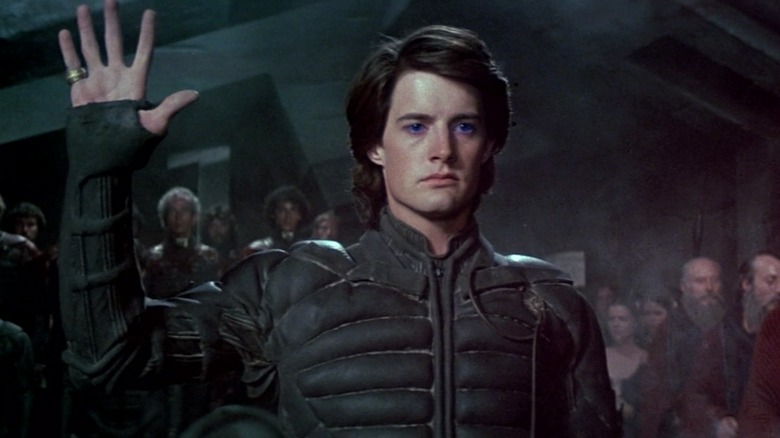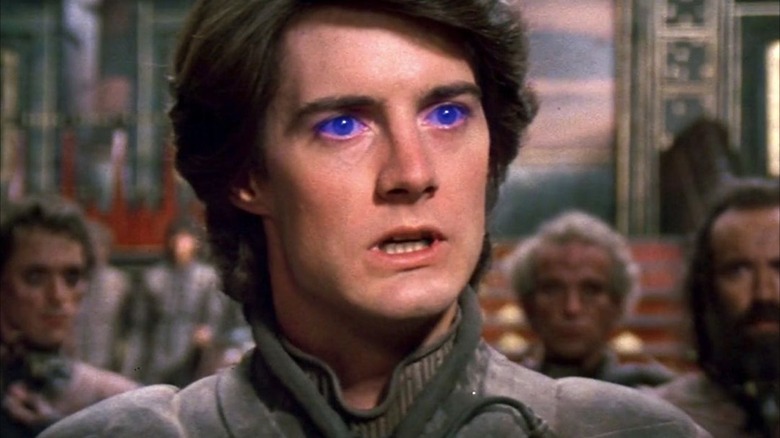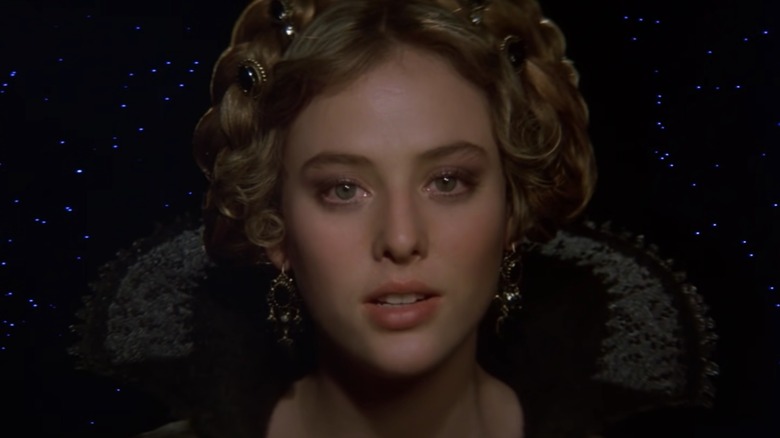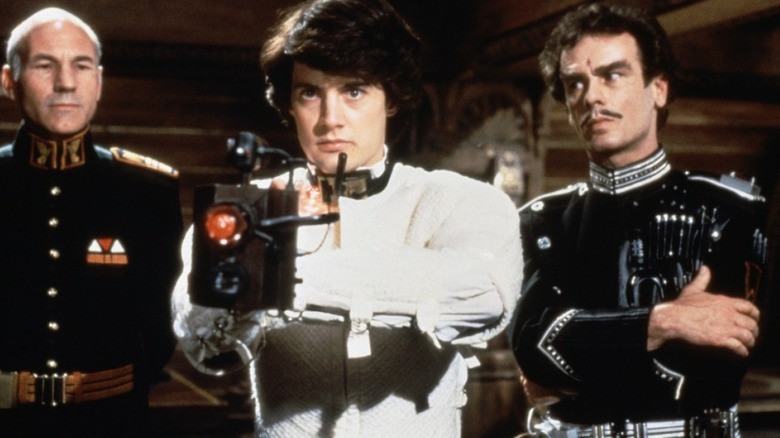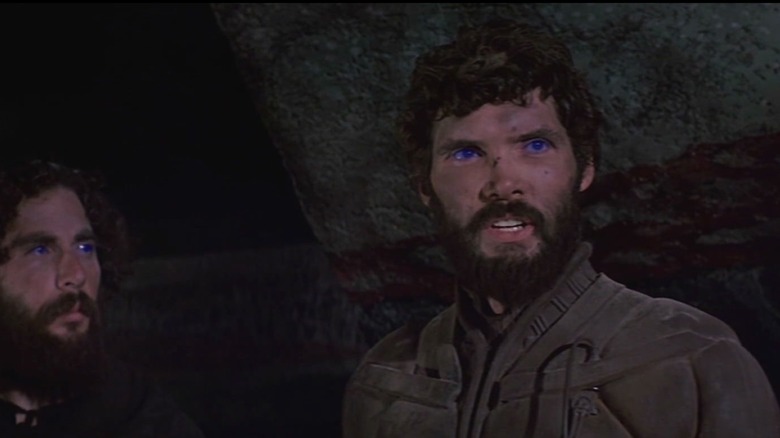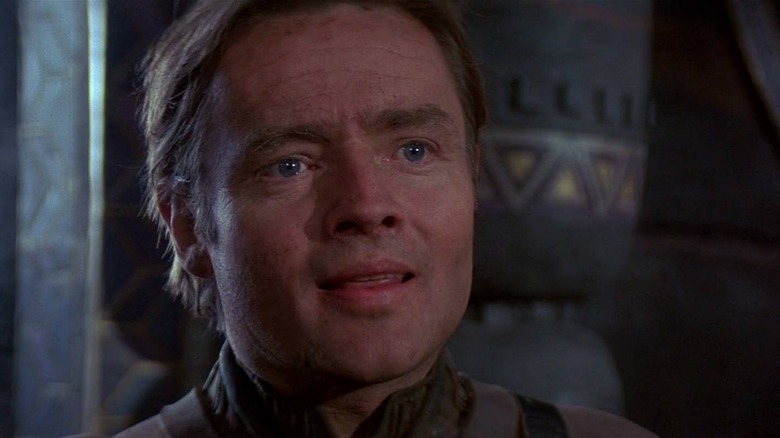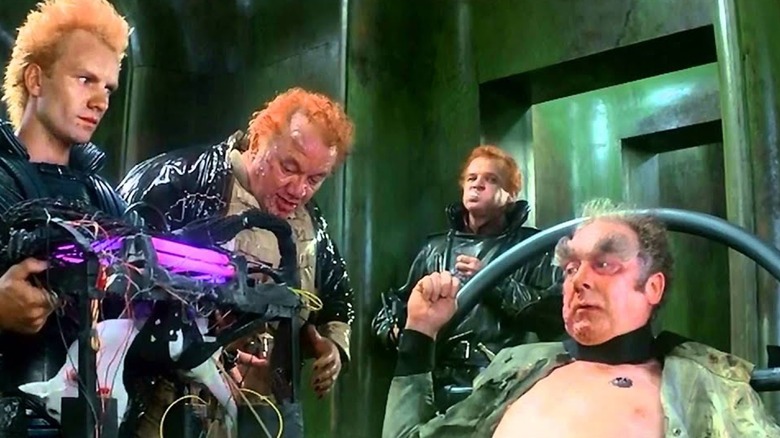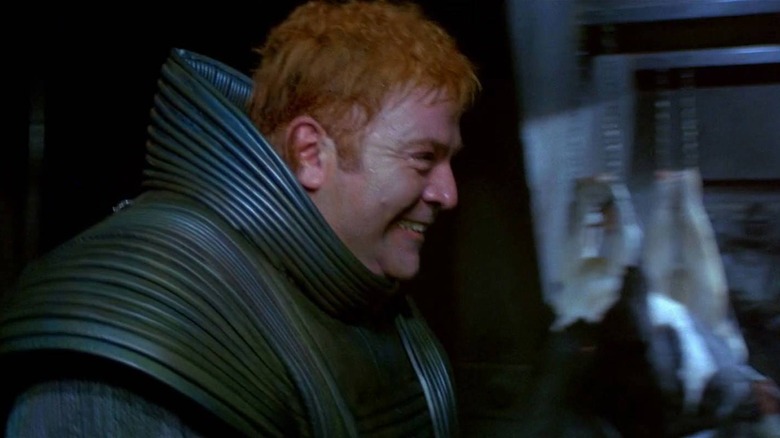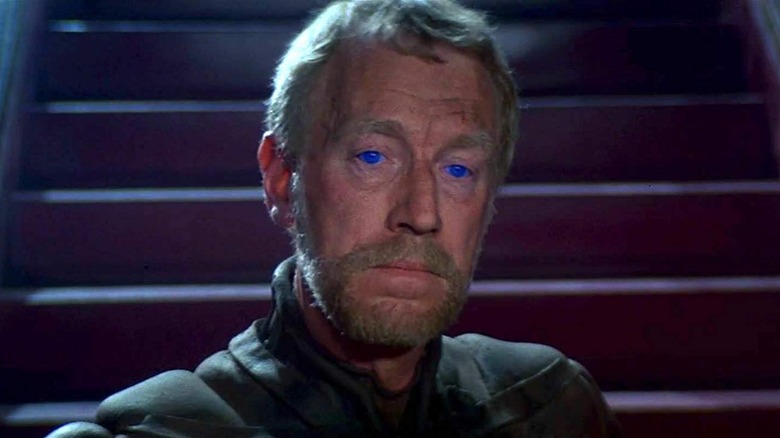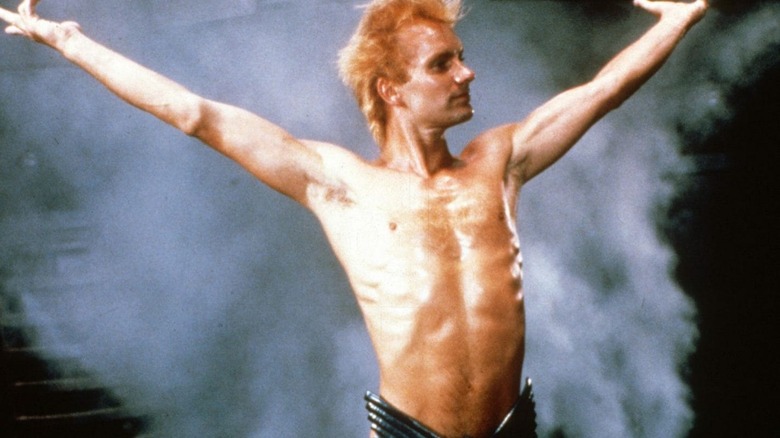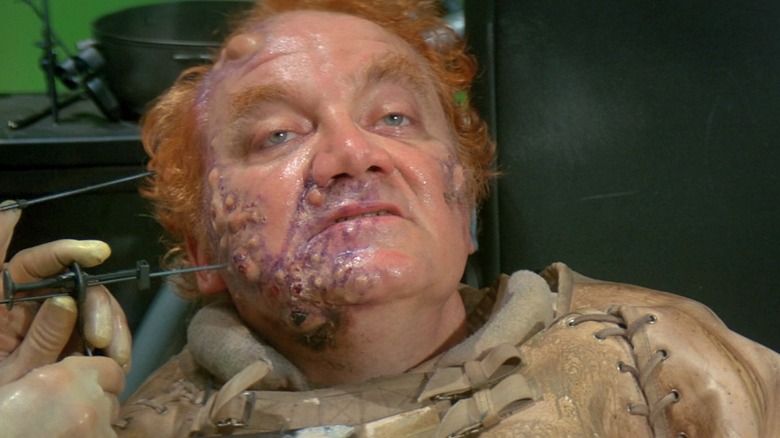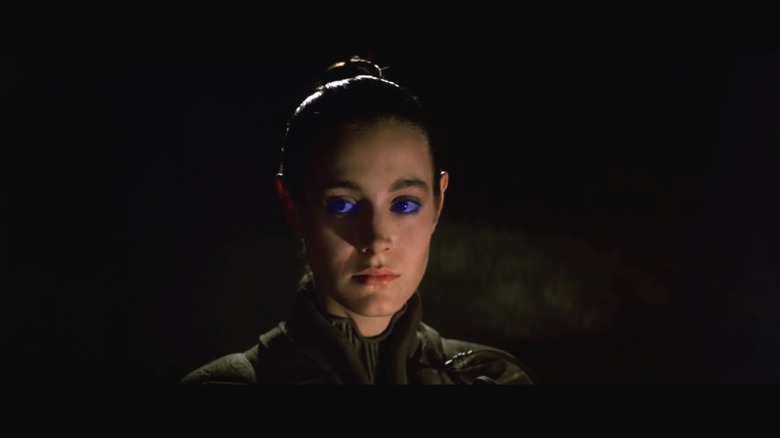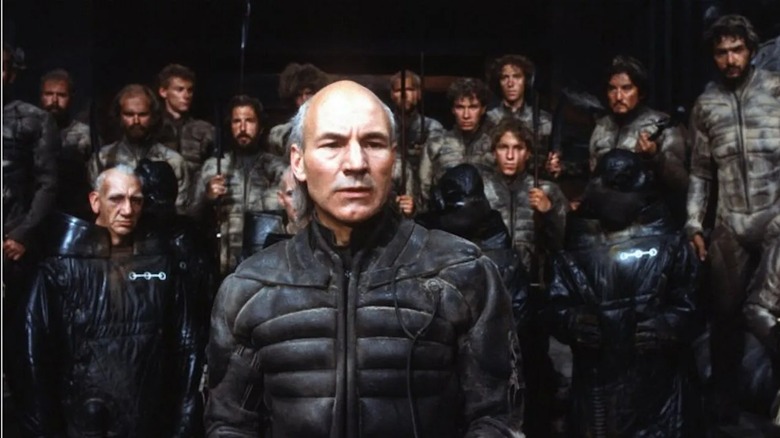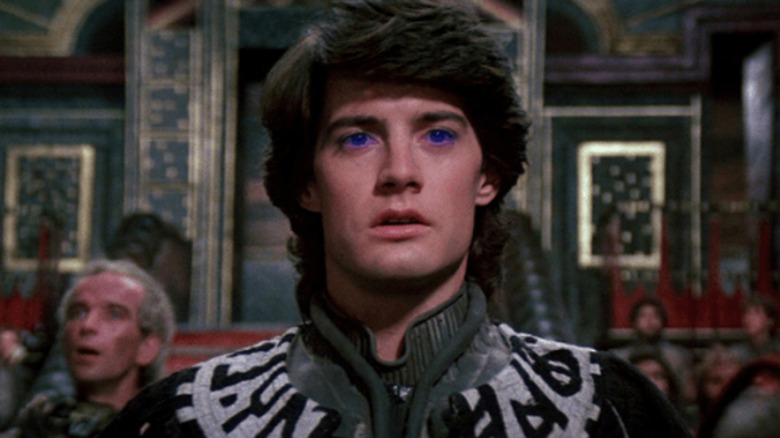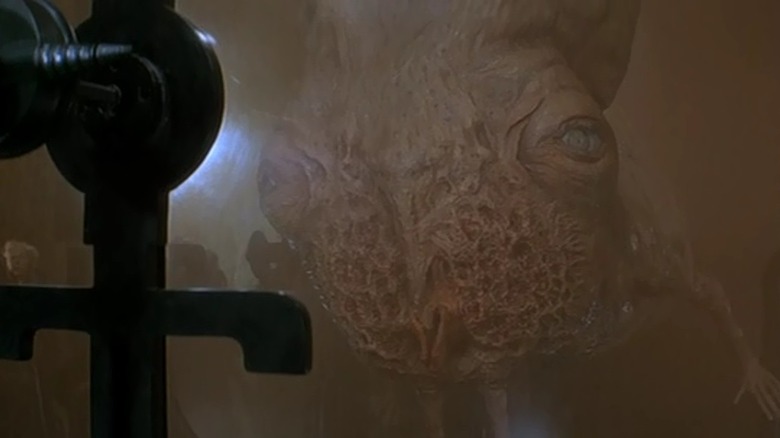Everything Wrong With 1984's Dune
David Lynch's version of "Dune" was released in 1984, and, with its erratic pace and variety of alternate, often unsanctioned versions, it's been notorious ever since. While your mileage will vary on whether or not it holds any of the weight of Frank Herbert's epic novel, it's a remarkable achievement to get a story critics still call unfilmable off the ground. Lynch's version is emphatically his in the right and weirdest of places. Ask a hardcore sci-fi movie fan if they remember the time a prisoner had to milk a cat to get the antidote he needs to live, then watch their face smooth over as they recall the horrifying memory. That's definitely a thing that happens in David Lynch's "Dune."
We're still waiting to see if that shot makes it into Denis Villeneuve's "Dune: Part Two." Tragically, probably not. Villeneuve did give us that creepy spider humanoid, though. Anyway, cat antidote milk isn't the only oddity to come out of Lynch's vision. It's a fantastically imaginative movie, approached with the right mindset. We're going to go over some of what's wrong with it, but that's no shade. We love this film. "Dune" is its own feverish spice dream. It does have some big flaws, however, and that's what we're going to sift through.
Dune required homework
The trouble with "Dune" started before moviegoers could even get into the theatre. Universal provided stacks of printed pamphlets to be given out with movie tickets, fearing that the dense world of Frank Herbert's novel would be too much for the average viewer to comprehend. The pamphlet was a double-sided glossary of terms; functionally a miniature version of the reference materials that bookend the original novel. As brief as it is, we're not sure how this single page could help a new fan's confusion without making them more anxious about what they're going to see.
Nobody got a pamphlet with "Star Wars," that's all we're saying. Nor did we get one with "Dune: Part One." Denis Villeneuve relied on the audience's ability to gather what these strange things were from their context, from Mentats to stillsuits. It's unfortunate that, in 1984, the studio didn't feel confident in Lynch's ability to do the same. The glossary has never been what confuses new fans about "Dune," and Lynch's film provides enough context about what matters to have been left alone.
The narrated introduction
Fans of Frank Herbert's novel can defend the idea of Princess Irulan's introduction to the theatrical release. Thematically, it makes good sense. In universe, she's the historian who will one day chronicle the rise of the Fremen Messiah, her royal consort, Paul Muad'Dib (Kyle MacLachlan). Without that information, the movie opens with this random, regally dressed woman (Virginia Madsen), who proceeds to dump a lot of exposition about the conflict between Houses Harkonnen, Atreides, and Corrino, then adds more about two opposing guilds, the Spacing Guild and the Bene Gesserit, all over something called the spice melange on a world named Arrakis, also known as Dune.
It's a chunky monologue, complete with an "I almost forgot," which is nonsensical for a historian's introduction. Equally unwieldy but a lot more cogent, the unsanctioned TV cut (aka the "Alan Smithee Cut"), provides a different introductory class. This methodical version, matched with fascinating concept art slides, is provided by Disney voice actor William Phipps instead. It's more useful, but both forget that film is its own medium. Letting Chani (Zendaya) talk naturally about her love of Arrakis in 2021's version is far more powerful.
The Weirding modules
We did just say that film is its own medium, but "Dune" took one look at the psychological use of mythos and mental mastery of the Bene Gesserit and set about turning it into something that would look cool on screen. The psychological mastery is still there, at least; Bene Gesserit alumni Lady Jessica (Francesca Annis) and Gaius Helena Mohiam (Sian Phillips) both use the Voice to handle tough situations around them. But House Atreides, rather than eying Dune for its desert power, set about attempting to weaponize the Voice into sonic death, with phaser-like amplifying modules handed out so that anyone with some brief training can kill with a word.
If that makes zero sense to you, you're right. Set aside that there's some minor sci-fi logic in going from vocal control to sonic weaponry. The Atreides have one trained Bene Gesserit on staff, Lady Jessica, and Thufir Hawat (Freddie Jones) never fully trusts her. In addition to this bottleneck, how did House Atreides think the Bene Gesserit would react when they found out? It never comes up in the film, but later volumes of the saga show that the Bene Gesserit rarely respond kindly to these kinds of transgressions. It also looks silly in the film.
The Whitest Fremen U Know
"Dune" is a parable about colonialism and resource domination, and the local religious militants are the closest we get to good guys. Based originally on a nonfiction text Frank Herbert was preparing, it's easy to see how we get to Arrakis from ecological disasters and oil conglomerates cutting up the Middle East. With further context in mind — the Fremen of Arrakis press a galactic jihad from "Dune Messiah" onward — it's tough to cast Fremen for a film and not fall into harmful stereotypes about Islam.
The solution was not to cast a variety of the whitest guys David Lynch could get. Stilgar, the Naib of Sietch Tabr — Naib is an Arabic word that, in this context, means an authoritative representative — is played by the stony white face of Everett McGill. Jamis is played by Judd Omen (white), his wife Sarah, who is 'claimed' by Paul, is played by Molly Wyrn (so white), and Chani is porcelain beauty Sean Young ("Blade Runner"). Basic logic suggests that generations on a desert world would leave you somewhat brown, in addition to dusty. This is remedied by Denis Villeneuve's "Dune," which partially remembers that Herbert had a relatively nuanced understanding of Islam, and casts people of color in a majority of its Fremen roles. Nobody Arabic, unfortunately — even Villeneuve isn't brave enough to hold that conversation.
Duncan Idaho's brief life
The subjectively "best" era of the Dune saga was published before the 1984 film, ending with "God Emperor of Dune" in 1981. With it, we already knew that Duncan Idaho, who dies in the first half of the first novel, gradually becomes one of the most important characters in the story. That importance does not come through in the original film at all. Idaho (Richard Jordan, "Logan's Run") is killed off unceremoniously, and in his few scenes previous to the assault on Arrakis doesn't forge a friendly enough bond with the young scion of House Atreides to make us buy into his new future of being a Trojan horse clone.
It's fair to note that Lynch had no intentions of turning "Dune" into a franchise, nor did anyone know how out of hand Idaho's importance would become in the Scattering arc and the revival novels by Brian Herbert and Kevin J. Anderson. But actor Jordan could at least have been given a chance to offer up his riveting charisma, a key aspect of Idaho's popularity. This is one place where Jason Momoa's 2021 incarnation especially shines. "Dune" fans could — and actually want to — see this version of Idaho reborn again. And again. And ... you get it.
Constant internal narration
The unwieldy info dump narration at the start of both versions of 1984's "Dune" isn't the only way the film unnecessarily explains itself. It also provides internal narration from most major characters. Invisible thought bubbles jam every scene as these whispering inner voices hold disjointed conversations with the events before them. It didn't work three years earlier in "Blade Runner," and it sure as hell doesn't work here, either.
It's another way "Dune" reveals that it doesn't have enough confidence in its audience to follow what's going on without clutching their hands and dragging them along. The result is baby food, pureed dialogue that leaves fascinating set pieces without any silence for us to study them. Not all of the internal narration is useless or annoying. We can make arguments for the spice dreams, for example, as the audience is itself part of the internal chorus. But that only underlines how flawed the constant mental chatter is. Worst is when it attempts to add character nuance the film couldn't make room for more effectively — Yueh (Dean Stockwell), with his internal whimpering about his captured wife Wanna, is a prime example of this flaw.
Caging the Beast Rabban
Count Glossu Rabban (Paul L. Smith) comes up short against the more diabolical members of his family. A Harkonnen brute granted dominion over Arrakis after the purge of the Atreides, Rabban isn't put in charge for his intelligence. He's there to scour their goodwill. But the novel gives him a deeper aspect — smart, he is not. But he's granted a common sense his wily family ignores, to their downfall. It's Rabban who notes that the Fremen are possibly a bigger threat than anyone realizes, and he's even a little introspective about his uncle's penchant for torturing his subjects.
Naturally, this is chucked out the window of the original film, which delegates Rabban to his title of Beast and not much else. He slouches menacingly, that's all, and his fate is to be left beheaded before the throne of Emperor Shaddam IV (Jose Ferrer). Thus far, it's not looking too great for the future of Dave Bautista's even more imposing version of Rabban. But at least they both get some screentime. In the novel, Rabban's death is an afterthought, a body left behind in one of the Fremen attacks beyond the flying palace of the Emperor.
The fall of Liet-Kynes
Max von Sydow was a brilliant actor who excelled at every performance, from the doomed knight at the heart of "The Seventh Seal," to voicing the historian Esben in "Skyrim." It's hard to misuse his talents, which consistently uplifted a project. "The Exorcist," especially, benefits from his quiet presence, a counterweight of serenity against the Devil itself. And yet, even before "Star Wars: The Force Awakens" managed to throw him away in a one minute cameo, there was "Dune" to prove you could screw it up.
Liet-Kynes, Judge of the Change and the chief ecologist studying Arrakis, is a small but important character in the novel. He's the axis point between worlds, a living example of the veil residents have to pass through before they turn Fremen. He's trapped by his duty to the Emperor, and when he betrays that duty in order to save the Atreides, whom he's come to respect, he's slain by the Harkonnens. It's a sequence of events that Villeneuve explains well in his version, but Lynch neglects the most important element of Dr. Kynes story. He's charmed by the Duke and his desert-wise son, but he doesn't help them in the siege of Arrakis. Instead the Harkonnens leave him to die in the sand, for no reason but to ensure we know they're evil.
Feyd-Rautha's plastic mankini
Call him Gordon Sumner, call him Sting. You know his voice, and if you've seen "Dune," you've seen his sweaty, rock hard abs. Sting plays Feyd-Rautha, the favorite nephew of Baron Harkonnen, and the one meant to rule Arrakis after Rabban softens it up. Lithe, feral, and nasty, Sting cuts a more handsome figure than the sunken-eyed goth killer the novel describes. Despite doing the role solely for the chance to work with David Lynch, Sting does offer an unhinged portrayal of the young Harkonnen, and it's one of the best performances in what's already a shockingly strong cast.
But Sting, allegedly, wanted to offer more than that. His character's introduction includes those shiny abs, as he steps out of a thick steam shower to grin at his uncle. It also includes an absurd blue-black plastic mankini covering the, ah, Stingiest bits downstairs. So the story goes, that was due to a last minute panic by the producers. Sting wanted to bare it all, exposing the total fearlessness of Feyd. It was a good idea, but too ahead of its time. Unfortunately, the plastic panties upend the scene into campy ridiculousness. Release the full Gordon cut!
The harmful stereotype of the fat, evil pedophile
Baron Vladimir Harkonnen is described hideously in the books, large enough to require a repulsor system to float. He's also depicted as a bisexual pedophile, incestuous, and unfortunately, one of the few clues to Frank Herbert's personal opinions. We're not claiming the Baron's portrayal in David Lynch's "Dune" is inaccurate. However, the film goes into detail about his predilections, adding layers to the Baron that are both stereotypical and openly homophobic.
Vladimir (Kenneth McMillian) molests and murders a young man in one of his earliest appearances. This Baron is erratic, his large body cursed with seeping boils and pustules. It's 1984, recall. The AIDS epidemic began in 1981, and had already been public news for two years. At this time, the fear, disgust, and abuse of those suffering from HIV was reaching a crescendo. The Baron plays into the public's fears of the time, associating queer coding with child abuse. Today, Stellan Skarsgard's new Baron holds a quieter menace, wielding his body as a threat. It's better, though none of this can erase what Frank Herbert intended, nor hide the existence of his second son, Bruce. A gay activist estranged from his father because of his sexuality, Bruce Herbert died of AIDS in 1993 at the age of 41.
If you or anyone you know has been a victim of sexual assault, help is available. Visit the Rape, Abuse & Incest National Network website or contact RAINN's National Helpline at 1-800-656-HOPE (4673).
Chani's relationship, undermined
Chani's relationship with Paul is a foundation upon which the new Atreides empire is born. Chani is a key figure in the novel, and a power in her own right. She undergoes heavy trials alongside Muad'Dib, including the loss of their first son (Leto II, whose name will be given to a later son) to a Sardaukar assault. Yet the 1984 film does frustratingly little with her. Sean Young brings the same regal distance to bear as she had in "Blade Runner," but her battle competency, her grief, and her struggles with what Paul is becoming don't get any time for discussion. The death of their child isn't even mentioned, nor is her connection to Liet-Kynes examined in depth. The Smithee cut gives her some scenes as a Bene Gesserit handmaiden of sorts, but still little else.
What she is, is a vision that guides Paul to the Fremen. A living plot coupon, essentially. In contrast, 2021's "Dune" amplifies the importance of Chani in Paul's visions, dazzling him equally with the promise of Arrakis' hidden beauty, and the knife in her hands. We only meet her in the flesh in the last half hour, but this time, it feels important in all the right ways.
Sardaukar? More like Suckaukar
Pardon the joke, but Duke Leto Atreides' fascination with the Fremen hinges on their potential to stand toe to toe with the Emperor's finest killers, shoring up his family's place as a contender for ruler of the Landsraad. The Sardaukar are forged from childhood on a prison planet famed for its hostile environment, and excel in all combat forms, from the physical to the psychological. Little of that world, Salusa Secundus, is revealed in Frank Herbert's novels, and it was a surprise to see its brutality depicted in Denis Villeneuve's version.
But in the 1984 film, the Sardaukar are ridiculous to behold. They're dressed in puffy garbage bags with green windows in their helmets, and their weapons are thick and clunky. It makes them a faceless, monolithic enemy, sure, but we don't get to see their potential prowess much. It's not a surprise to see Lynch's Fremen barely bother with their intended parallels on screen, but it is a disappointment. Even the SyFy miniseries of "Dune," which has rated no worthwhile mentions thus far, more accurately depicted these warriors like the Roman Legionnaires and Ottoman Janissaries that inspired them.
The incoherent pacing
"Dune" opens with three minutes of Princess Irulan infodumping. With the rest of the theatrical cut barely over two hours long, it still takes 40 minutes to get to Arrakis. 20 minutes later, the Atreides compound on Arrakis is struck by joint Harkonnen and Sardaukar troops. At an hour and twenty, Paul fights Jamis, wins, and here's where the 2021 version ends. But hold on! Lynch has just started trucking for the finish line.
At the 90-minute mark, Paul tames his first worm, and just four minutes later he's leading war bands and reconnecting with Gurney Halleck. After more quick cuts, the Fremen warrior elite, the Fedaykin, are established, Paul takes the Water of Life, and the Emperor is on his way to Dune. Some quick napkin math shows that a full third of the story, including the important stuff that establishes Paul's evolved soul as intended for Arrakis' trials, is crunched into 15 minutes or less. That is an absurd pace; it's like watching a horse trot for most of the Belmont Stakes, only to panic and try to gallop the last quarter mile to the finish line. Rest assured, the Smithee cut isn't that much better — the back half is still cramped to the point of incoherency.
Rain on Arrakis
The Kwisatz Haderach is the ultimate goal of the Bene Gesserit, an ubermensch — with all the historical weight that entails intended — capable of bridging both the masculine and feminine spiritual world. It's a dangerous gift, once trained, and the psychic pressure of the Kwisatz Haderach is hard for an onlooker to deny. It's not meant to offer free superpowers, though, and 1984's "Dune" ends on a truly ridiculous note that undermines literally everything else in the epic.
With an intent, slack-jawed stare, Paul brings rain to Arrakis. It causes his little sister to note that this means he is, in fact, the Kwisatz Haderach. What it actually means is that he's just destroyed space travel for several millennia, as the rain would kill the sandworms and the spice they produce. It ignores that a similar situation is mentioned in the novel as a threat, using the Water of Life to destroy all spice production. It's total control over a vital resource, and Lynch's "Dune" washes it all away with some showy power creep. A green Arrakis is a dream for the Fremen, true. But not like this.
The Alan Smithee cut
The television cut of "Dune" adds 39 minutes to the film's hearty two-hour-plus runtime. As noted earlier, it's known as "the Alan Smithee cut." After an argument with the studio, who assembled this version without his input, David Lynch demanded that his name be taken off and the film branded with the infamous pseudonym as its director. It's the final defense for directors unhappy with studio interference.
As Lynch also held screenwriting credit, he was able to dig the knife in further. Judas Booth is his new moniker, blending the man who betrayed Jesus with the assassin who killed Lincoln. The TV cut is long enough to add new context and better explanation for several major events, but it achieves this with raw, sometimes reused footage and unfinished FX. Studio interference at this level is rarely for the best, and Lynch's frustrations remain respectable today.
It's probably fair to think that Lynch's trials paved the way for Denis Villaneuve to work without extra hands in his soup. It's that same difficulty, however, that keeps the full epic of "Dune" considered "unfilmable," and why even the new version draws critique over how much has to be lost to tell its core story of a troubled Messiah.
